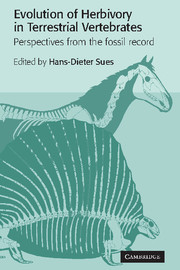Book contents
- Frontmatter
- Contents
- List of contributors
- Preface
- 1 Herbivory in terrestrial vertebrates: an introduction
- 2 Herbivory in late Paleozoic and Triassic terrestrial vertebrates
- 3 Prosauropod dinosaurs and iguanas: speculations on the diets of extinct reptiles
- 4 The evolution of sauropod feeding mechanisms
- 5 Plant-eaters and ghost lineages: dinosaurian herbivory revisited
- 6 Dental constraints in the early evolution of mammalian herbivory
- 7 Patterns in the evolution of herbivory in large terrestrial mammals: the Paleogene of North America
- 8 Origin and evolution of the grazing guild in Cenozoic New World terrestrial mammals
- Taxonomic index
- Subject index
7 - Patterns in the evolution of herbivory in large terrestrial mammals: the Paleogene of North America
Published online by Cambridge University Press: 22 October 2009
- Frontmatter
- Contents
- List of contributors
- Preface
- 1 Herbivory in terrestrial vertebrates: an introduction
- 2 Herbivory in late Paleozoic and Triassic terrestrial vertebrates
- 3 Prosauropod dinosaurs and iguanas: speculations on the diets of extinct reptiles
- 4 The evolution of sauropod feeding mechanisms
- 5 Plant-eaters and ghost lineages: dinosaurian herbivory revisited
- 6 Dental constraints in the early evolution of mammalian herbivory
- 7 Patterns in the evolution of herbivory in large terrestrial mammals: the Paleogene of North America
- 8 Origin and evolution of the grazing guild in Cenozoic New World terrestrial mammals
- Taxonomic index
- Subject index
Summary
Introduction
This chapter examines the evolution of herbivory among the larger terrestrial mammals (ungulates and ungulate-like mammals) of the Early Tertiary (Paleogene, encompassing the Paleocene, Eocene, and Oligocene epochs). There are sound reasons for examining paleoecological trends in large mammals separately from small ones, both in terms of the allometry of the ecological attributes of living mammals (see Brown 1995) and in terms of paleontological and taphonomic biases (see Fortelius et al. 1996).
The term ‘herbivory’ is used to refer to diets that include primarily plant material, as opposed to animal material. In this chapter, I especially emphasize the evolution of the more restricted form of herbivory, folivory, meaning the consumption of only the fibrous, structural parts of the plants, such as stems and leaves. Folivorous mammals today include both browsers and grazers. (There were no grasslands in the Early Tertiary to support the latter dietary habit.) These mammals have some sort of symbiotic association with micro-organisms in the gut for cellulose fermentation. Folivores are usually contrasted with frugivores, that is animals that eat primarily fruit and other non-structural parts of the plant. There is also a category of ‘frugivorous/folivorous’ mammals, which take a mixture of fruit, seeds and leaves but do not select fibrous food requiring fermentation.
Exclusively herbivorous mammals must be above a certain body size (approximately one kilogram) because plant material does not contain enough nutrition per unit volume to support the metabolic rate of smaller endotherms (Kay 1975). Some small (i.e., less than 1 kg in body mass) extant mammals, such as voles and other specialized rodents, can be exclusively herbivorous by virtue of being ‘granivorous,’ specialized for taking grass seeds.
- Type
- Chapter
- Information
- Evolution of Herbivory in Terrestrial VertebratesPerspectives from the Fossil Record, pp. 168 - 222Publisher: Cambridge University PressPrint publication year: 2000
- 20
- Cited by



